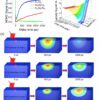One popular example of chaotic behavior is the butterfly effect—a butterfly may flap its wings in somewhere in the Atlantic Ocean and cause a tornado in Colorado. This remarkable fable illustrates how the extreme sensitivity of the dynamics of chaotic systems can yield dramatically different results despite slight differences in initial conditions. The fundamental laws of nature governing the dynamics of physical systems are inherently nonlinear, often leading to chaos and subsequent thermalization.
However one may ask why are there no rampant increase in tornados in Colorado caused by a massive disappointment of butterflies in global affairs, such as say global warming? This is because physical dynamics, although chaotic, are capable of demonstrating remarkably stable states. One example is the stability of our solar system—it obeys nonlinear laws of physics, which can seemingly induce chaos in the system.
The reason for this stability relies on the fact that weakly chaotic systems may display very ordered periodic dynamics that can last for millions of years. This discovery was made in the 1950s by great mathematicians Kolmogorov, Arnold, and Moser. Their discovery, however, works only in the case of systems with a small number of interacting elements. If the system includes many constituent parts, then its fate is not that well understood.
Researchers from the Center for Theoretical Physics of Complex Systems (PCS) within the Institute for Basic Science (IBS), South Korea have recently introduced a novel framework for characterizing weakly chaotic dynamics in complex systems containing a large number of constituent particles. To achieve this, they used a quantum computing-based model—Unitary Circuits Map—to simulate chaos.
Investigating time scales of chaoticity is a challenging task, requiring efficient computational methods. The Unitary Circuit Map model implemented in this study addresses this requirement. “The model allows for efficient and error-free propagation of states in time,” Merab Malishava explains, “which is essential for modeling extremely weak chaoticity in large systems. Such models were used to achieve record-breaking nonlinear evolution times before, which was also done in our group.”
As a result, they were able to classify the dynamics within the system by identifying time and length scales that emerges as thermalization dramatically slows down. The researchers found that if the constituent parts are connected in a long-range network (LRN) manner (for example in an all-to-all manner), then the thermalization dynamics are characterized by one unique time scale, called the Lyapunov time. However, if the coupling is of a short-range network (SRN) nature (for example nearest neighbor) then an additional length scale emerges related to the freezing of larger parts of the system over long times with rare chaotic splashes.
Typically the studies on such sensitive dynamics are done using the techniques of analyzing the behavior of observables. These techniques date back to the 1950s when the first experiments on chaoticity and thermalization were performed. The authors identified a novel method of analysis—by investigating the Lyapunov spectrum scaling.
Merab Malishava says: “Previous methods might result in ambiguous outcomes. You choose an observable and seemingly notice thermalization and think that the dynamics are chaotic. However if another observable is studied, from another perspective, then you conclude that the system is frozen and nothing changes, meaning no thermalization. This is the ambiguity, which we overcame. The Lyapunov spectrum is a set of timescales characterizing the dynamics fully and completely. And what’s more, it’s the same from every point of view! Unique, and unambiguous.”
The results are not only interesting from a fundamental standpoint. They also have the potential to shed light on the realizations of quantum computers. Quantum computation requires coherent dynamics, which means no thermalization. In the current work, a dramatic slowdown of thermal dynamics was studied with emerging quasi-conserved quantities. Quantizing this case could possibly explain such phenomena as many-body localization, which is one of the basic ideas for avoiding thermalization in quantum computers.
Another great accomplishment of the study relates to the applicability of the results to a vast majority of physical models ranging from simple oscillator networks to complex spin network dynamics. Dr. Sergej Flach, the leader of the research group and the director of PCS explains: “We have been working for five years on developing a framework to classify weakly chaotic dynamics in macroscopic systems, which resulted in a series of works significantly advancing the area. We put aside narrowly focused case-by-case studies in favor of fostering a conceptual approach that is reliable and relatable in a great number of physical realizations. This specific work is a highly important building block in the aforementioned framework. We found that a traditional way of looking at things is sometimes not the most informative and offered a novel alternative approach. Our work by no means stops here, as we look forward to advancing science with more breakthrough ideas.”
This research was recently published in Physical Review Letters.
More information:
Merab Malishava et al, Lyapunov Spectrum Scaling for Classical Many-Body Dynamics Close to Integrability, Physical Review Letters (2022). DOI: 10.1103/PhysRevLett.128.134102
Provided by
Institute for Basic Science
Citation:
Novel framework for classifying chaos and thermalization (2022, April 5)



